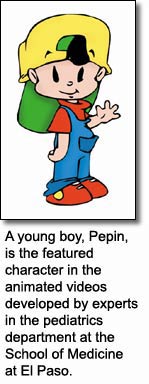Texas Tech Health Sciences Center
Award-Winning Cartoon Character Communicates Health Messages to Parents, Children
An unassuming 8-minute animated cartoon featuring a mischievous little
boy named Pepin has educated a bilingual population of children and their
parents in 
El Paso for the past 12 years while winning critical acclaim at international film festivals. The videos also have led to further research in communicating with patients in an unconventional method.
The cartoon character Pepin was born in 1993 from a need to deliver health messages and information in an entertaining, yet effective manner to children. The project is a joint effort between Ciudad Juarez, Chihuahua, Mexico and El Paso. It was funded by a grant from the W.K. Kellogg Foundation to the Department of Pediatrics in the Texas Tech School of Medicine at El Paso.
“Pepin is a model child for educating children and parents,” says Marie Leiner, Ph.D., assistant professor. “We wanted a generic child without nationality or association to ethnic groups. This way, anyone could identify with him.”
Initially, Pepin videos taught children about violence, dental hygiene, nutrition and recycling. However, after observing the interest of parents, the videos also were produced to improve the communication of health issues to adults on such topics such as vaccines, child development and anticipatory guidance . Today, these videos are used in day care centers, clinics and Head Start programs around the city.
Most physicians working with underserved populations agree that communication is a major challenge in managing patients because misunderstandings often occur in populations with poor or non-existent reading skills. Add a language barrier, and the likelihood of the message getting across drops dramatically, according to Leiner.
Faculty and others in the Department of Pediatrics sought to change the form of the message delivery. Cartoon animations had not been used much in educational information or in communications for patients, and only a handful are now using cartoon illustrations with the corresponding written material, says Leiner.
Recently, a Pepin video won a Silver Remi Award at the 38th Worldfest-Houston Film Festival. The video, "DtaP Vaccine,” portrays a mother taking her baby to a pediatrician for an innoculation. The video also includes information on the vaccine, vaccination risks and contact information in case of an adverse effect.
Worldfest-Houston International Film Festival is a competitive, independent film festival held annually in Houston. It recognizes and honors outstanding creative excellence in film and video from around the globe.
Several research studies have been initiated in the last few years to observe the effects of social learning using videos, comics and pictorials. The studies include residents and faculty from the pediatric department led by Leiner, Associate Professor Pratibha Shirsat, M.D., and Regional Chairman and Professor Gilbert Handal, M.D.
Printed materials, computer-based programs, graphics and a combination of easy-to-read written materials with added oral instructions-video programs have proven to be among the most successful ways to deliver messages and improve communication with patients. Videos have proven to increase short-term knowledge, and they out-performed plain written materials, lectures and even individual counseling.
Video programs have the advantage of retaining viewer attention for longer periods of time. Marketers and advertisers know that to change behaviors, a longer attention span is necessary.
By using marketing tools in patient education materials, a person can move from knowledge to action, according to Leiner, who has a degree in chemical engineering and marketing.
Leiner says the intent of using these presentations is to alter the behavior of the viewer, and to affect the level of awareness, knowledge and attitude toward the product or service offered. Leiner says this project has led to a number of research studies on the effects of improving communication with Hispanic patients through pictorials and/or comics.
- Lisa Ruley
